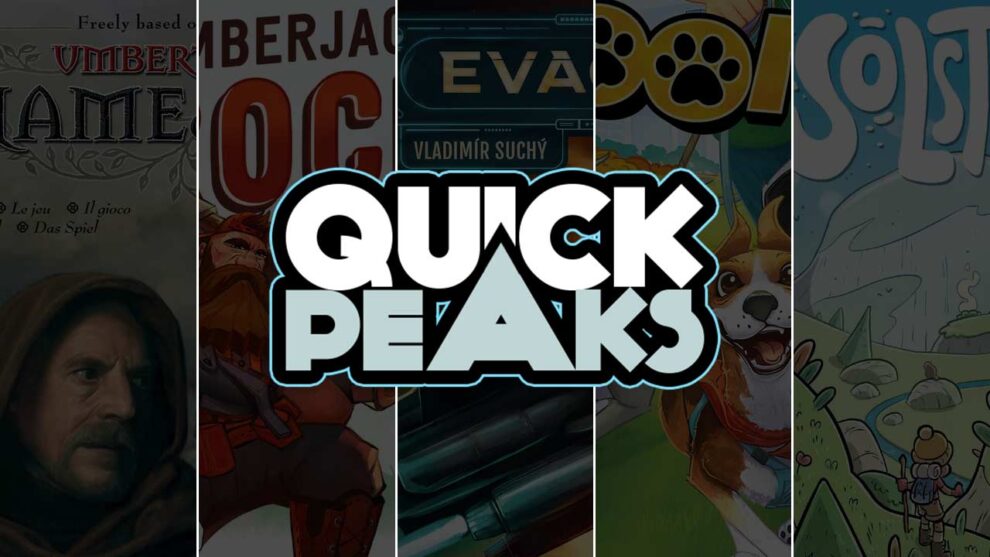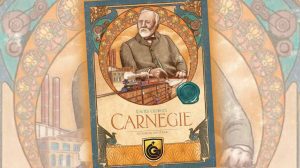The Name of the Rose – Justin Bell
For a solid 20 minutes, I was dumbfounded by a number of surprises when my friends Beth and John stopped by for game night with a copy of The Name of the Rose. The game is based on the 1980 debut novel by Italian author Umberto Eco and the 1986 abbey-based murder mystery film starring Sean Connery as William of Baskerville—a movie I had never heard of, despite my general appreciation for Connery films both high and low (The League of Extraordinary Gentlemen, in a shocking turn, did not win Best Picture in its year of release.) The game’s cover couldn’t possibly afford to use Connery’s likeness, so I had to go online before I believed that the real film even featured Connery along with an early-career Christian Slater. The final shock was the biggest one: The Name of the Rose was designed by Stefan Feld, one of the premier Eurogame tabletop game designers of modern times.
Despite a heavy volume of red flags, I’m shocked to share that The Name of the Rose was actually…pretty good! It’s a deduction game played over six rounds, featuring a mechanic that allows players to access all figures in the game while taking on the identity of one of six monks who may or may not be a murderer. There are suspicion tracks and monk cards and shenanigans that need to be used to help mask a player’s true identity. The final stage asks players to guess the monk-color identity of other players, in an effort to have the lowest score at the end of play to ensure that you are the player who raised the least suspicion during play.
Stefan Feld has a reputation—rightly earned—as a master of the “point salad” Eurogame design philosophy (games where players often get points for simply taking actions, even if they are not strategically the right or best ones), starting with popular releases like The Castles of Burgundy and Trajan as well as later releases such as last year’s Civolution, a game that is a bit divisive around these parts. The Name of the Rose features none of that. It’s highly interactive as a deduction game. There are no dice. (Yes, this is a Feld game!!!) The playtime is crazy short—our three-player game took about an hour. The Name of the Rose is not an all-timer, but it is a highly recommended thriller, especially if you can get five players to the table.
Ease of entry?
★★★★☆ – The odd bump or two
Would I play it again?
★★★★☆ – Would like to play it again
Read more articles from Justin Bell.
Lumberjacks With Rocket Launchers – Kevin Brantley
With such an absurd title, how could you not take a second glance at this pocket-sized card game? The game plays exactly as it sounds—you’re lumberjacks shooting rocket launchers at each other, and the last one standing wins. Prolific Games/Left Justified Studios is known for its lumberjack-themed games, and this one fits nicely into their catalog.
It sounds simple enough, but how does it fare in (target) practice? It’s a blast with the right group. Since the game features player elimination, it’s best played with friends who enjoy taking playful jabs at each other, especially over a few beers at the pub. Players draw a card and play one to either their left or right, aiming at those players. Rocket cards are straightforward: if a player has three rockets pointed at them, they could blow up and be eliminated. Various cards can reverse or destroy rockets, and some even allow them to “pass through,” meaning a rocket can move through another player into a different lane. Think of it as a chaotic game of hot potato, but with rockets circling the table. You don’t want to get caught holding them.
It’s a breezy, fun, and simple game—and the more players, the better. Though the game officially supports up to eight players, it could accommodate more due to the large deck. The first third of the game starts slow since there aren’t enough rockets in play (yet), but as time goes on, the table becomes a chaotic mess of rockets flying in every direction. The game is largely luck-driven; sometimes, you just won’t draw the right cards to defend yourself or blow someone up, leaving you at the mercy of your neighbors.
Don’t overthink this one—it’s meant to be fast, stabby, and chaotic. Just remember: there are no friends among lumberjacks when they’re packing ballistic weaponry.
Ease of entry?:
★★★★☆ – The odd bump or two
Would I play it again?:
★★★☆☆ – Wouldn’t suggest it, but would happily play it
Read more articles from Kevin Brantley.
Evacuation – David McMillan
I have been dying to play Evacuation ever since I became aware of its existence in the months leading up to Essen 2023. In his review of Evacuation, my fellow writer Justin Bell spoke about how he thinks Evacuation is best at four players. I can neither confirm nor deny that statement as my only experience with the game is the single two-player game I recently had the pleasure of finally getting to play, and let me tell you, it was well worth the wait.
My favorite aspect of the game is the delicate push-and-pull of having to manage two different resource pools at the same time. There were multiple instances that made me feel like I was a certified genius, and there were multiple instances that made me feel like I was the exact opposite. For instance, I had this grand plan in mind to successfully evacuate my final two tiles from the Old World during the final round, and these plans were all centered around the acquisition of a specific ship from the lineup. However, I stupidly forgot that the last ship in the lineup gets dropped in between rounds, so my careful planning went straight out the airlock. This whole plan had to be slapped together in the first place because of another mistake I had made earlier when I foolishly forgot to leave myself enough energy to send one of my ships from the New World back to the Old World at the end of the previous round.
This is all to say, Evacuation is a brilliant design, but it’s definitely not an easy one. If juggling multiple pools of resources isn’t your thing, then this is probably not the game for you. But, that kind of thing is right up my alley, and Vladimir Suchy does not disappoint when it comes to providing this kind of experience.
I absolutely cannot wait to get this game to the table again!
Ease of entry?
★★★★☆ – The odd bump or two
Would I play it again?
★★★★☆ – Would like to play it againRead more articles from David McMillan.
Zoomies – Justin Bell
My man Andy Matthews recently sent me a copy of Zoomies, so I got it to the table with my wife and eight-year-old son. Zoomies is a tile placement game featuring dogs, double-sided scoring tokens, a small measure of hand management, and a 20-minute playtime across eight turns. It’s also a game that has a strange set of scoring mechanics.
On a turn, a player adds one of their two domino-style tiles to an ever-changing board featuring domino halves in five dog breed types. Then, they add a scoring token to one half of their newly-placed domino. Three of the four scoring options are relatively simple—one scores for bone symbols on the printed tiles, while another scores points simply for the number of matching dog types in the same contiguous area. One is a little tricky: Frens (which, strangely, is not Friends, so I’m guessing Frens is a dog-related term??) and that pays off if you can make one type of dog more friendly with a different breed situated in nearby tiles. All three of these types give you a small drip of points that will score at the end of the game.
But the fourth type is the Zoomies scoring mechanic—players can score as many as 15 points simply by placing a tile with a paw print icon on it, as long as it is touching other paw icons (regardless of breed) in an orthogonal line. The paw icons are not rare, either…so that led to a pretty simple strategy: get one or two, ideally three, Zoomies tokens placed to score points, and that will probably win you the game. Zoomies scoring is so overpowered that even the eight-year-old said that the Zoomies power “is crazy OP.” As a game, Zoomies was otherwise fine, but in a world with a billion other tile-laying games, it is hard to imagine getting this one back to the table.
Ease of entry?
★★★★☆ – The odd bump or two
Would I play it again?
★★☆☆☆ – Would play again but would rather play something else
Read more articles from Justin Bell.
Solstis – Andy Matthews
Even though I love board gaming, I don’t get to play as often as I would like. This phase of life makes it tough sometimes to get even one other person to play. So when I do get a chance to sit down at the table I want to dive in and soak it all in. When I was handed a copy of Solstis from Hachette Games at GAMA Expo I was tentatively excited. The artwork and graphic design is awesome, and having Bruno Cathala’s name on the box certainly didn’t hurt either. Plus I enjoy two player games, so to the table we went!
This small box contains a panoramic tile laying game in which players attempt to connect as many of the distinct tiles of the mountain in their personal play area. Keep in mind that there’s only one mountain. So when your opponent takes a tile, they’re depriving you of that same tile. There is much randomness, but also a bit of “chicken”. If your opponent picks up a tile that goes next to a tile in YOUR area, that could mean they might want some of the same tiles as you.
You score points for each tile in your largest connected area, plus you’ll earn points for spirits you collect (by connecting 4 tiles in a square). Players also score for having lit fire icons (only on the highest tiles in the mountain) which connect to lower tiles on the mountain. The most appealing thing about the game is assembling the tiles after you’re finished into the completed panorama. Illustrator Gorobëi has done a superb job with a single large illustration, with loads of details, gorgeous line work, and a calm and relaxing color palette. If you’re looking for a casual game with just a bit of bite, then Solstis might fit the bill.
Ease of entry?
★★★★☆ – The odd bump or two
Would I play it again?
★★★★☆ – Would like to play it again















